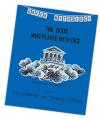For the ancient Greeks the most powerful manifestation of nature was the wind or more accurately the winds.
The wind would change the seasons, bring the clouds and the needed rain but also punish men with hail, storms and thunder.
The wind would either protect the soil or let it be parched and scorched by the blazing sun.
And even more importantly the ancient Greeks had discovered that no living creature could live if his or her inner wind would stop: the respiration.
Life depended on winds.
In Homer it is explained that the ruler over the winds was Aeolus, he would keep all the winds locked up in a bag and would only release them only when he or the gods decided to reward or punish the humans.
The mighty Aeolus also known by his title as “ the keeper of winds” was credited with 12 sons , their mother was Eos, the Titan goddess of the dawn.
The Gods of the Winds are always depicted as men with wings attached to their shoulders, but usually with different expressions and attributes
The four most important sons and winds were called the Anemoi, the ones corresponding to one of the four cardinal directions (North, South, West, East) from which they came.
The four gods were :
- Boreas (North Wind),
- Notus (South Wind),
- Zephyrus (West Wind)
- Eurus (East Wind).
Boreas, the cruel North Wind, was often described as a bearded old and rough man with wings, who held a conch shell. He was closely associated with winter, as he was the bringer of cold and low temperatures.
The Athenians venerated Boreas because they believed that it was the North Wind who helped them to destroy the Persian fleet in 492 BCE.
Notus, the Southern wind, was considered dangerous as it would blow after midsummer, causing the crops to burn and bringing the bad weather of late summertime.
He was usually represented as a young man with long hair, with dew coming from his wings
He kept in his hands a vessel for water, a hydria — from which the rain gushed out.
Eurus the beneficial Eastern wind was represented as a matured man slightly bold. He was also known by the surname of Argestus, the bearer of brightness.
He also brought the bad storms, but he was more kind to people than his brothers Boreas and Notus. He was described as a curly-headed man with an unkempt beard and with a sadness in his face.
The Spartans worshiped Eurus considered there as the Saviour of Sparta because of his refreshing rain.
Zephyrus, the light Western wind pictured as a young handsome man, often with his lover the nymph Claris, who would spread flowers .
He would bring the spring time and end the harsh winter. He was of course the favourite of every one and especially of the poets.
But there were also :
- Hellespont symbolised with a torment ,
- Apheliotes or Euronotus was the god of the south east wind and was usually pictured with a basket full of fruits and wheat. He brought the refreshing rain. He was represented as a curly-haired man with a friendly expression, dressed in a light cloth with some flowers tucked beneath
Notus and his closest brothers Euronotus and Lips or Livos or sometimes also Libanotos would send warm and even burning hot wind
- Libanotos, Lips or Livos , god of the southwest wind, would be shown as a teenage boy with his cheeks blowing ,
- Argestes, the Northwest wind, shown sometimes as a star , would bring cold rain and hail
- Traxias, god of the Northwest wind usually depicted with a crown of clouds with strong icy winds and storms.
- And finally the terrible Aparctias from the far away North , frowning , with a bushy beard sending the most terrible icy biting wind.
- Caecus, the northeast wind, had a bad name in Greece as the bearer of snow, coldness and blizzards. This was the reason why he took this name and why he had this image. He was represented as a man frowning with long hair and a bushy beard. Hail drops from his round vessel, which he always carries.
In Athens you can visit the beautiful “Tower of the Winds” in the Roman Agora in Plaka, it is considered to be the world’s first meteorological station.
The tower, which was built as a horologion (time-clock) in the first century BCE by the Syrian architect Andronicus Cyrrhestes, was made on the ground-plan of the eight angles corresponding to the eight gods of winds. The reliefs of the eight personifications of the winds decorate the frieze all around the tower.

